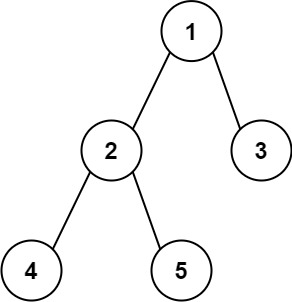Problem
Given the root of a binary tree, return **the length of the *diameter* of the tree**.
The diameter of a binary tree is the length of the longest path between any two nodes in a tree. This path may or may not pass through the root.
The length of a path between two nodes is represented by the number of edges between them.
Example 1:

Input: root = [1,2,3,4,5]
Output: 3
Explanation: 3 is the length of the path [4,2,1,3] or [5,2,1,3].
Example 2:
Input: root = [1,2]
Output: 1
Constraints:
The number of nodes in the tree is in the range
[1, 10^4].-100 <= Node.val <= 100
Solution (Java)
/**
* Definition for a binary tree node.
* public class TreeNode {
* int val;
* TreeNode left;
* TreeNode right;
* TreeNode() {}
* TreeNode(int val) { this.val = val; }
* TreeNode(int val, TreeNode left, TreeNode right) {
* this.val = val;
* this.left = left;
* this.right = right;
* }
* }
*/
class Solution {
private int diameter;
public int diameterOfBinaryTree(TreeNode root) {
diameter = 0;
diameterOfBinaryTreeUtil(root);
return diameter;
}
private int diameterOfBinaryTreeUtil(TreeNode root) {
if (root == null) {
return 0;
}
int leftLength = root.left != null ? 1 + diameterOfBinaryTreeUtil(root.left) : 0;
int rightLength = root.right != null ? 1 + diameterOfBinaryTreeUtil(root.right) : 0;
diameter = Math.max(diameter, leftLength + rightLength);
return Math.max(leftLength, rightLength);
}
}
Solution (Javascript)
/**
* Definition for a binary tree node.
* function TreeNode(val, left, right) {
* this.val = (val===undefined ? 0 : val)
* this.left = (left===undefined ? null : left)
* this.right = (right===undefined ? null : right)
* }
*/
/**
* @param {TreeNode} root
* @return {number}
*/
var diameterOfBinaryTree = function(root) {
let diameter = 0;
dfs(root);
return diameter;
function dfs(node) {
if (!node) return 0;
const left = dfs(node.left);
const right = dfs(node.right);
// update diameter at every node
diameter = Math.max(diameter, left + right);
// update the max path of the current node
// 1 is the height of the node itself + longest path of children
return 1 + Math.max(left, right);
}
};
Explain:
nope.
Complexity:
- Time complexity : O(n).
- Space complexity : O(n).